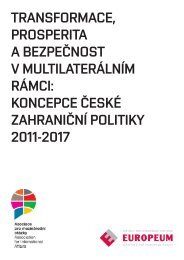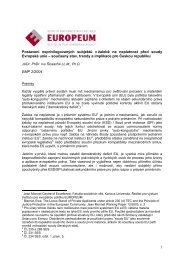eu constitutionalisation - EUROPEUM Institute for European Policy
eu constitutionalisation - EUROPEUM Institute for European Policy
eu constitutionalisation - EUROPEUM Institute for European Policy
You also want an ePaper? Increase the reach of your titles
YUMPU automatically turns print PDFs into web optimized ePapers that Google loves.
Chapter 4: Government Coalitions and Institutional Re<strong>for</strong>m at the IGCg HOSLI, M. O. (1999) Power, connected coalitions, and efficiency: Challenges tothe Council of the <strong>European</strong> Union. International Political Science Review,20(4): 371-391.g HOSLI, M. O. and ARNOLD, C. (2005) Cleavages, Coalition-Formation and EasternEnlargement: Negotiating the <strong>European</strong> Constitution. Domestic Structuresand <strong>European</strong> Integration (DOSEI) Final Conference. Brussels.g HUG, S. and KÖNIG, T. (2002) In view of ratification: Governmental preferencesand domestic constraints at the Amsterdam Intergovernmental Conference.International Organization, 56(2): 447-+.g JOHNSTON, A. I. (2001) Treating, international institutions as socialenvironments. International Studies Quarterly, 45(4): 487-515.g KAEDING, M. and SELCK, T. J. (2005) Mapping Out Political Europe: CoalitionPatterns in EU Decision-Making. International Political Science Review/Revue internationale de science pol, 26(3): 271-290.g KÖNIG, T. and BRAUNINGER, T. (2004) Accession and re<strong>for</strong>m of the <strong>European</strong>Union – A game-theoretical analysis of eastern enlargement and theconstitutional re<strong>for</strong>m. <strong>European</strong> Union Politics, 5(4): 419-439.g LAURSEN, F. (1992) Explaining the Intergovernmental Conference on PoliticalUnion. IN LAURSEN, F. and VANOONACKER, S. (eds.) The IntergovernmentalConference on Political Union. Maastricht: <strong>European</strong> <strong>Institute</strong> of PublicAdministration.g LAURSEN, F. (ed.) (2002) The Amsterdam Treaty: National Preference Formation,Interstate Bargaining and Outcome, Odense: Odense University Press.g LAURSEN, F. and VANHOONACKER, S. (eds.) (<strong>for</strong>thcoming January 2006) TheTreaty of Nice: Actor Preferences, Bargaining and Institutional Choice,Leiden: Academic Publishers Brill.g LEIGH-PHIPPARD, H. (1996) Coalitions and contact groups in multilateraldiplomacy, Leicester: Leicester University Centre <strong>for</strong> the Study of Diplomacy.g LEWICKI, R. J., SAUNDERS, D. M. and MINTON, J. W. (eds.) (1999) Negotiation,Third Edition, Columbus, OH: Richard D. Irwin and McGraw-Hill.g LITTLE, G. (1986) Political ensembles: a psychosocial approach to politicsand leadership, Melbourne; Ox<strong>for</strong>d: Ox<strong>for</strong>d University Press.g MAGNETTE, P. and NICOLAIDIS, K. (2003) Large and small member states inthe <strong>European</strong> Union: reinventing the balance: Notre Europe.g MAGNETTE, P. and NICOLAIDIS, K. (2004) The <strong>European</strong> convention: Bargainingin the shadow of rhetoric. West <strong>European</strong> Politics, 27(3): 381-404.g MAGONE, J. M. (2004) Contemporary Spanish Politics, London: Routledge.g MARCH, J. and OLSEN, J. P. (2004) The Logic of Appropriateness. ARENAWorking Papers.Chapter 4: Government Coalitions and Institutional Re<strong>for</strong>m at the IGCg MARCH, J. G. and OLSEN, J. P. (1989) Rediscovering institutions:the organizational basis of politics, New York: Free Press.g MATTILA, M. (2004) Contested Decisions: Empirical Analysis of Voting in the<strong>European</strong> Union Council of Ministers. <strong>European</strong> Journal of Political Research,43(29-50.g MIDGAARD, K. and UNDERDAL, A. (1977) Multiparty Conferences. In: DRUCKMAN,D. (ed.) Negotiations: Social-psychological perspectives. London: SagePublications.g MORAVCSIK, A. (1993) Preferences and Power in The <strong>European</strong>-Community –A Liberal Intergovernmentalist Approach. Journal of Common Market Studies,31(4): 473-524.g MORAVCSIK, A. (1999) The choice <strong>for</strong> Europe: social purpose and state powerfrom Messina to Maastricht, London: UCL Press.g MORAVCSIK, A. and NICOLAIDIS, K. (1999) Explaining the treaty of Amsterdam:Interests, influence, institutions. Journal of Common Market Studies, 37(1): 59-85.g MORGAN, R. and BRAY, C. (1986) Partners and rivals in Western Europe:Britain, France and Germany, Aldershot: Gower.g NAJAM, A. (2001) Getting beyond the lowest common denominator: Developingcountries in global environmental negotiations. PhD Thesis. Department ofUrban Studies and Planning. Boston: MIT.g NORMAN, P. (2003) The <strong>European</strong> Convention: Divided into the final weeks,Briefing Note, No. 2.1 June 3, 2003, Brussels: EuroComment.g OSTROM, E. (1999) Institutional Rational Choice: An Assessment of the InstitutionalistAnalysis and Development Framework. IN SABATIER, P. A. (Ed.) Theories of the<strong>Policy</strong> Process. Boulder, Colorado and Cumnor Hill, Ox<strong>for</strong>d: Westview Press.g PALACIO, A. and CIMOSZEWICZ, W. (2003) How to keep the balance in Europe’snew treaty. Financial Times: 26 September 2003.g PEDERSEN, T. (1998) Germany, France and the Integration of Europe, Londonand New York: Pinder.g PETERSON, J. and BOMBERG, E. E. (1999) Decision-making in the <strong>European</strong>Union, Basingstoke: Macmillan.g PIERSON, P. (1996) The Path to <strong>European</strong> Integration: A Historical InstitutionalistAnalysis. Comparative Political Studies, 29(2): 123-163.g PIERSON, P. (2000) The limits of design: Explaining institutional origins andchange. Governance, 13(4): 475-499.g PIJPERS, A. (ed.) (2000) On Cores and Coalitions in the <strong>European</strong> Union, TheHague: Clingendael.g POWELL, W. W. and DIMAGGIO, P. (1991) The New institutionalism inorganizational analysis, Chicago; London: University of Chicago Press.140141








